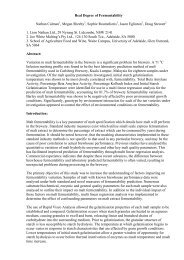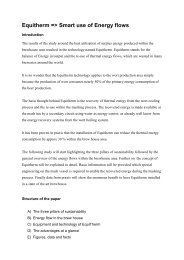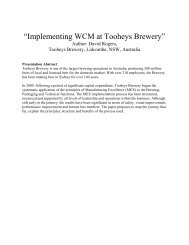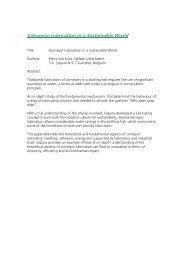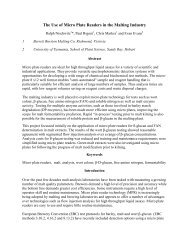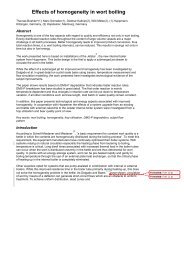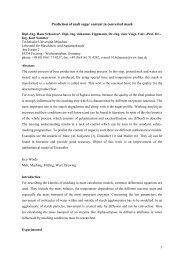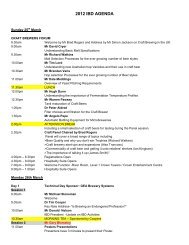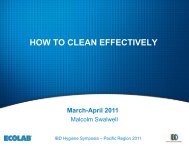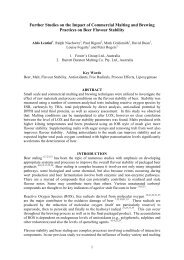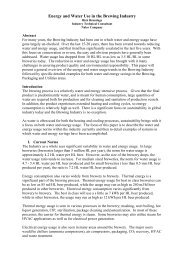Bitter Apples For Cider Making - An Alternative
Bitter Apples For Cider Making - An Alternative
Bitter Apples For Cider Making - An Alternative
Create successful ePaper yourself
Turn your PDF publications into a flip-book with our unique Google optimized e-Paper software.
Experimental<br />
Cultivar evaluations: Fruitlet samples were collected by cultivar. Some<br />
were sub-sampled into “large” or “small” fruitlets to assess the relative influence<br />
of size and date. Fruitlet samples were measured for average diameter, then<br />
weighed. 100 - 200 grams of the fruitlets were then cut into small pieces before<br />
grinding and mixing with a hand held “Bamix” unit. Grinding with, and without,<br />
metabisulphite at circa 300 mg / kg was trialed. A sample of the ground pulp was<br />
then placed in a disposable 10 mL syringe and approximately 2 mL of liquid<br />
collected through a 0.45 um, 25 mm dia, cellulose acetate filter disc.<br />
.<br />
Total Polyphenol levels were measured using a standard Fosters method<br />
(Costanzo, 2003) based on the ASBC and EBC International Method.<br />
The juice samples were diluted 10 fold by volume with distilled water by<br />
modifying the method and including 150 uL of sample instead of the usual 1500<br />
uL, and increasing the distilled water to make up the same volume<br />
The following aliquots were added to a disposable cuvette:<br />
• 800 uL CMC / EDTA reagent<br />
• 150 uL of sample<br />
• 50 uL of Ferric Reagent (samples only)<br />
• 50 uL Ammonia reagent<br />
• 1450 uL of distilled water (use 1500 uL for blank)<br />
After mixing and allowing a reaction time of 10 minutes, the absorbance<br />
was measured against a reagent blank at 600 nm wavelength in a<br />
spectrophotometer. Final result is calculated by multiplying corrected<br />
absorbance at 600 nm x 547 x dilution factor to give results in mg/L.<br />
Processing plant trials: A total of 185 tonnes of fruit thinnings were<br />
collected over a period of 5-7 weeks from mid November until the end of<br />
December. These were collected into waist belt held picking bags, before<br />
consolidation into 0.4 tonne holding bins. The bins of fruitlets were hydro-cooled,<br />
then stored in cool store at 4 degrees C until delivery to the processing plant on<br />
the day of processing.<br />
Fruit was processed on 6 Dec, 13 Dec, 21 Dec and 8-10 January. Milling<br />
occurred using a Rietz mill (10 mm screen) with addition of sodium<br />
metabisulphite solution at milling to give a level of approximately 300 mg/kg<br />
SO2. Some additional water was also added at milling to facilitate pumping to<br />
the mash holding tanks. Pectolytic mash enzyme was added at a rate of<br />
approximately 300 mL/Tonne, before holding for 1 – 2 hours at 20 – 25 degrees<br />
C. Juice was extracted using a Bucher HPX5005i fruit press, then flash<br />
pasteurised into agitated fining tanks where fining agents silica sol and bentonite<br />
were applied. The juice was then cross-flow filtered in a Bucher “Ministar –metal”<br />
unit employing Graver technologies filter elements having 0.1 micron pore size<br />
titanium oxide membranes supported on 316 sintered stainless steel. Finally, the<br />
juice was concentrated in an APV rising / falling film plate evaporator to around



